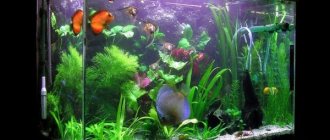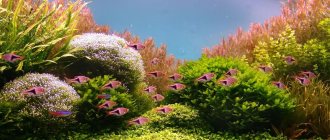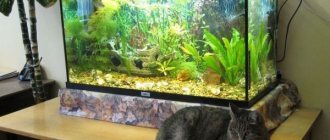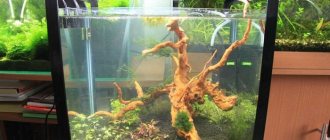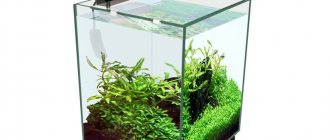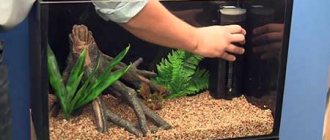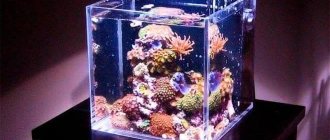A large 200-liter aquarium will enliven the interior of any spacious room. But before you bring such a bulky structure into your home, it is worth learning about the features of choosing, installing and equipping the future water area. Yes, and you need to populate it wisely. In this article, we will take a closer look at the characteristics of such a container, and also get acquainted with the nuances of its operation.
Advantages and disadvantages
Despite its rather large dimensions, a 200 liter aquarium is much easier to care for than a 20-30 liter jar. With stable care, it is almost impossible to upset the established biobalance. In addition, the choice of inhabitants is much greater than for small containers.
But there are also some disadvantages. For it you need to choose a quiet and not sunny place. There should be no TV or speakers near the container. The noise will make the fish scared and hide. The stand on which the 200 liter aquarium will stand must be very durable. You cannot place such a capacity on a regular table or chest of drawers. After all, only an empty container weighs 40-45 kg, and a container filled with water and soil placed on the bottom will weigh approximately 250-300 kg.
Starting and maintaining an aquarium
The purchased aquarium, decorations and soil are thoroughly washed. After installing the container, the substrate is poured into the prepared area and decorative elements are placed. Next, install the equipment - filter, compressor, heater. Then the aquarium is filled with water. Turn on the equipment and leave it running around the clock. After 3-7 days, plants are planted; at the same time, turn on the lighting, gradually increasing the duration of daylight hours. After 1-2 weeks, shellfish and unpretentious fish are released.
Caring for a 200-liter aquarium consists of weekly replacement of 20-30% of the volume with fresh water. As it gets dirty, siphon the soil and wash the filter, and also clean the glass. Overgrown plants are trimmed and thinned out every few months.
Shape and size options
The most affordable and convenient option for a city apartment is considered to be a standard rectangular aquarium with parameters of 1000 mm in length, 370 in width and 550 in height. The thickness of the glass is 8 mm, the area of the side surfaces is 354x550, the front surfaces are 1000x550.
Without water, an empty aquarium weighs about 18-20.5 kg, but transportation requires the help of a delivery service. Together with water, the weight will increase significantly. It’s easy to calculate: the volume of water converted into kilograms, plus the weight of the glass, plus the soil and the necessary equipment.
Based on this, it is worth not only choosing a reliable cabinet, but also thinking about the reliability of the beam floors. The latter is especially true for old buildings, which are unlikely to be designed for loads exceeding 200 kg.
If the reliability of the building is beyond doubt, you need to think about the shape of the future water area. In addition to the standard rectangle, today we offer a large selection of corner, wall and panoramic aquariums made of silicate and polymer glass.
The former save a lot of space, but since they are installed at the joints, it can be difficult to determine the leak area of the aquarium. A wall-mounted aquarium is also economical, it also looks stylish, but caring for the inhabitants of such a tank is very difficult. The panoramic version of the aquarium looks original due to the concave glass, but this format distorts the natural dimensions and is demanding on lighting. A more successful option is the trapezoidal shape, which also provides excellent visibility, but without significant distortion.
A new trend has become the emergence of a screen aquarium, which allows you to zone a room. Its inhabitants are visible from all sides, and the cloudiness of the water is not so noticeable.
However, in such aquariums, fish often suffer from a lack of oxygen, so these designs need to be equipped with an additional set of filters.
If the delights are not too interesting, you should pay attention to ordinary rectangular containers with a cabinet. Once the desired shape has been selected, you can proceed directly to purchasing an aquarium.
Plants
A 200-liter pond is suitable for growing large, long-stemmed and flowering plants. Species with elongated shoots and leaves, as well as those characterized by a high growth rate, are planted along the back wall and in the corners of the tank. Medium-sized plants and slow-growing species are placed in the center. Ground cover and low-growing plants are placed in the foreground. Driftwood and stones can be decorated with moss, secured with fishing line. Floating plants are used to create diffuse lighting. It should be remembered that some types of plants require the supply of carbon dioxide and fertilizer.
How to choose?
To choose a high-quality container, you should listen to the following recommendations.
- Do not sign any documents until you have thoroughly inspected the aquarium.
- Inspect the container for scratches and cracks. The former will be annoying already at the start-up stage, and the latter can cause the collapse of the aquarium wall and the death of its inhabitants.
- The seams should be smooth, without dips or bumps. There should be no traces of sealant on the walls of the aquarium.
- The tank cannot contain chips or abrasions, and its ends must be sanded.
- It will be necessary to have stiffening ribs - strips of glass up to 5 cm wide, glued perpendicular to the walls of the aquarium.
When purchasing an aquarium from a pet store, the buyer is provided with a warranty card. If you plan to buy the container secondhand, you should pay attention to the price already at the selection stage: an option that is too budget-friendly should raise questions about the quality of the aquarium.
If the seller refuses to share information about the condition of the container, you need to look for a more adequate consultant. During a personal meeting, you should make sure that the future house for the fish is in perfect order, and the equipment (if any is included) is in good condition.
Choosing fish for a marine aquarium.
Paradoxically, I want to start this section with the mistakes of beginners.
Basic mistakes of newbies:
- Overcrowding the aquarium and not leaving enough space for future fish growth.
- Introducing fish into the main aquarium without quarantine
- Introducing new fish into the main tank without adequate socialization
- Introducing aggressive and territorial fish into the aquarium first
- Keeping fish of varying aggressiveness
- The belief that all big fish are aggressive and all small fish are calm
- Buying adult and large fish at once, rather than small and young forms
- Periodically adding “another fish” to the aquarium.
- Buying fish on a “euphoric” market based on a picture without properly studying the features of maintenance, care and behavior.
Now that we know about the mistake, we are strong and will not allow them! Knowledge is power!
I’ll just list those who can be chosen without a twinge of conscience at the first stage of settlement, because they are stable and unpretentious:
- Amphiprion ocellaris Amphiprion oceliaris
- Amphiprion clarkia
- Amphiprion frenatus (tomato) Amphiprion frenatus
- Swallowfish Chromis viridis Chromis viridis
- Bicolor blennyfish Ecsenius bicolor
- Blennyfish Salarias fasciatus
- Cardinal fish Pterapogon cauderni
- Lionfish Pterois Volitans (for large volumes)
- Foxfish Siganus vulpinus (for large quantities)
- Yellow Zebrasoma flavescens (for large quantities)
This is not an ironclad list. In future articles I will talk about advanced fish selection.
I also want to mention those fish that a beginner should avoid.
BEGINNERS AVOID the following fish:
- Angelfishes:
- Apolemichthys species: all
- Desmoholacanthus arcuatus
- Centropyge bicolor
- Pomacanthus xanthometopon
- Pomacanthus imperator
- Pomacanthus navarchus
- Centropyge multifasciata
- Pygoplites diacanthus
- Holacanthus tricolor
- Holacanthus venusta
- Anthias – all
- Platax pinnatus
- Butterfly fish - everything
- Oxymonacanthus longirostris
- Zanclus cornutus
- Family Scaridae - all
- Rhinomuraena quaesita
- Family Syngnathidae - all
- Plectorhinchus chaetodontoides
- Surgeons
- Acanthurus Achilles
- Acanthurus lineatus
- Acanthurus leucosternon
- Naso vlamingii
- Acanthurus nigricans
- Family Malacanthidae - all
- Wrasse:
- Labroides spp.
- Macropharyngodon spp.
- Anampses spp.
Methods for choosing the number of fish.
SELECTION BY MAXIMUM FISH SIZE. Remember the rule : 1 cm of fish per 2 liters of water (if there is an LCD of at least 30% of the volume of the aquarium, skimmer). For example: We want 10 fish. We look in the atlas for information about the maximum size that a fish can reach and count: 3 x 10 cm, 2 x 7 cm, 1 x 15 cm, 1 x 12, 6 x 5 cm. Total: 30+14+15+12+30 = 101 cm multiplied by 2 liters = 202 liters. We buy a 200 liter aquarium. ATTENTION, this is considered if you select by the maximum (reference) size of the fish that they can reach, and not by the actual one!
CHOICE BY ACTUAL FISH SIZE. I recommend 3-4 liters of sea water per 1 cm of fish (if there is LCD at least 30% of the volume of the aquarium, skimmer).
Also in the guide we pay attention to the minimum volume of an aquarium for fish. If the minimum aquarium size in the directory is larger than our calculated size for the entire system, then we do not take such fish.
I recommend using this reference book: Atlas of marine aquarium fishes. Dr. Burgess's. Third edition. You may find completely different numbers in other sources, so I recommend choosing one “star” to guide you.
How to work with the directory
A couple of fish combinations for different aquarium sizes:
- Aquarium about 150 liters: Amphiprion ocellaris – 2 (pair)
- Sphaeramia nematoptera – 2
- Nemateleotris magnifica – 1-2 or Gobiosoma oceanops – 2-3
- Cryptocentrus spp. – 1 (if possible + shrimp of the genus Alpheus spp.) or Amblyeleotris spp. – 1 (if possible + shrimp of the genus Alpheus spp.)
- Aquarium about 200 liters: Chrysiptera parasema – 3-5
- Halochoeres chrysus – 1-2
- Centropyge loricula – 1 or Neocirrhites armatus – 1
- Escenius midas – 1 or Salaris fasciatus – 1
- Siganus vulpinus – 1 or Zebrasoma flavescens – 1 (they require an aquarium at least 120 cm long)
- Aquarium 200 – 300 Paracanthurus hepatus – 1-2
- Chromis viridis – 5-7
- Centropyge bispinosa – 1
- Oxycirrhites typus – 1
- Pterapogon kauderni – 2-3
- Aquarium 300-400 liters: Centropyge argi – 1
- Gramma lotero – 2 or Gramma melacara – 2
- Apogon maculates –2
- Myripristis jacobus – 1-2
- Serranus tortugarum – 3
As a replacement you can use:
- Bodianus pulcellus
- Lioproma rubre
- Aquarium over 400 liters: Pterois volitans or Dendrochirus zebra
- Rhinecanthus aculeatus or Odonus niger
- Paracirrhites arcatus
- Zebrasoma xanthurum or Zebrasoma flavescens
As a replacement you can use:
- Cephalopholis urodeta
- Echidna nebulosa
- Gymnomuraena zebra
Above is a selection of more aggressive and larger fish.
When we have decided on the number and types of fish, open the atlas of sea fish and write down the maximum sizes of the selected fish: 2 x 15 cm, 3 x 10 cm, 2 x 8 cm, 3 x 9, 2 x 6 cm, 1 x 12 cm. Total: 30 +30+16+27+12+12= 127 cm multiplied by 2 liters = 254 liters. We buy a 250 liter aquarium. Once again, please note that this is a method of calculating the number of fish based on the maximum size and not the actual size.
How many fish can you keep in a 200 liter aquarium?
You can calculate the number of fish using different methods, but all of them are not accurate. Therefore, it is best to select fish according to the table amount of water per individual or using a ready-made calculator. In addition, it is necessary to take into account the physical and chemical properties of water and the temperature in which certain fish live. We will write the number of fish for aquariums with normal filtration and weekly maintenance. To do this, divide the fish into groups.
Small fish up to 4 cm in size . These are rasboras, neons, cardinals, guppies, rhodostomuses, platies. On average, one fish should have 1-2 liters of water. If the aquarium is planted and an external filter is installed, the number of liters per individual can be reduced. But in any case, make sure that the aquarium looks good visually.
For small fish ranging in size from 6 to 10 cm, approximately 8-10 liters of water per individual are required. These fish include thorns, scarlet barbs, Sumatran barbs, fire barbs, minors, swordtails, and mollies. A 200 liter aquarium can contain a flock of 10-20 individuals. Again, with a large number of plants and good filtration, the number of fish can be increased slightly. Choose the quantity so that they don't feel like they're in a can.
Medium peaceful fish up to 20 cm in size will look very good in a 200 liter aquarium. For example, in 200 liters you can house two pairs of angelfish, several swordtails and a pair of ancistrus. Instead of Ancistrus, you can place a flock of Corydoras. Such a population will look harmonious, and the aquarium will not seem empty.
Golden angelfish
Goldfish will be excellent inhabitants for such a container. To make them comfortable, plant 4-5 individuals. Large and beautiful gouramis are peaceful fish. There should be 30 liters per pair of fish. They look good with angelfish and mollies.
Small cichlids include fish up to 10 cm in size, Cichlazoma Sedzhik, Black-striped Cichlazoma, Apistogramma Kakadu and Ramirezi, Pelvikachromis pulcher, Cichlazoma Eliot and others. These are territorial fish that live in pairs. To make them comfortable, create a lot of shelters, divide the territory with snags, large stones or large plants. A pair of fish should have 40 liters of water. So, in a 200-liter aquarium, 2 pairs of sedjiks and a pair of ancistrus catfish or synodontis catfish can live. In such conditions the fish will be comfortable.
Apistogramma of a cockatoo
Malawian cichlids are aggressive fish. To disperse aggression, the aquarium with them must be overpopulated. A 200 liter aquarium can accommodate about 15 fish. In this case, the rule applies: the more fish, the calmer.
Fish up to 20 cm in size - severum, turquoise acara are kept in a 200 liter aquarium in pairs, a male and a female. You don’t need to add anyone to them, but if you really want to, you can add one of the catfish, for example, synodontis or a couple of ancistrus. The fish are large, so they produce a lot of waste. The container must be equipped with an external filter and compressor. Don’t forget about weekly cleaning of the aquarium.
As you can see, a 200 liter aquarium can contain many fish. Create appropriate conditions for them and enjoy the beauty of the aquarium world.
Other inhabitants
You can also keep other aquatic inhabitants in a 200 liter aquarium. Freshwater shrimp get along well with fish; they collect uneaten food residues from the ground and destroy algae. Some varieties of these arthropods are painted in bright colors - red, blue, yellow, green. Also, crayfish are suitable for an aquarium of this size, but as neighbors for them you should select large fish that these arthropods cannot hunt. It is useful to introduce snails into the aquarium, which will eat excess food. In addition, frogs can live in the reservoir - clawed frogs and hymenochirus.
How to equip?
It is no coincidence that the equipment was mentioned: immediately after purchasing an aquarium, you should select the necessary devices that will support life in your home water area.
Setting up a 200 liter aquarium is not much different from a smaller tank. It also requires a heater, filter, compressor and siphon. Filters can be external, internal, built-in or mounted. If the choice fell on filters without aeration, purchasing a compressor is simply a must. Particular attention should be paid to lighting. It is no coincidence that aquariums are immediately sold with a lid, or this necessary attribute is purchased separately. After all, it is on the inside of the cover that LED lamps or LED spotlights are installed.
These light sources have gained great popularity due to their silent operation, long service life and low power consumption. It is important that during long-term operation (over 50 thousand hours) the spectrum of emitted light does not change. LED spotlights are resistant to mechanical damage, increased water resistance and safety since they do not contain mercury. Another advantage is their low heat transfer: they do not heat the water in the aquarium, so the liquid does not need constant cooling.
If you plan to add corals to your home water area, you should take a closer look at more powerful metal halide lamps. Their luminous flux is much wider than that of LEDs.
However, metal halide lamps are incandescent, so they should be mounted at a distance of 30 cm from the aquarium surface, which creates additional inconvenience when caring for the inhabitants of the aquarium.
Decor
The design of a 200-liter aquarium can either imitate the natural habitat of aquatic organisms or be decorative. It should be combined with the interior of the room. However, when designing an aquarium, it is necessary to take into account not only the desired appearance of the artificial reservoir, but also the needs of its inhabitants.
The background is attached to the back wall. Film backgrounds are fixed outside, and volumetric backgrounds are fixed inside the tank. Soil is laid at the bottom of the reservoir. The thickness of its layer and particle size depend on the needs of the plants that will be planted in the tank. Some species require a nutrient substrate.
The decorations used depend on the chosen aqua design. You can use natural objects (stones, driftwood) and artificial ones (caves, castles, ships, chests, etc.).
Where to install?
As a rule, the installation location of the aquarium is determined long before its purchase. But when the container with the equipment has arrived from the store, you should make sure that the “parking” of the future water area will really not disturb anyone, and that the inhabitants of the home pond will be comfortable. The cabinet with the aquarium should be in a quiet, dark place, away from the TV screen, computer and stereo system. At the same time, there should be plenty of space around it so that maintaining the aquarium and caring for the inhabitants does not cause discomfort.
Ideally, next to the container there should be an outlet with a tee through which light, heaters, and filters will be connected.
If one is not nearby, you will have to pull the cord from the extension cord, which will create additional inconvenience. There are often cases when beginners try to place an aquarium according to Feng Shui: in the northeast or south of the apartment for an influx of finances or on the east side to soften the tense home atmosphere.
If these parties meet the conditions for a comfortable life for fish, they are worth listening to. But if there are sleeping places in the so-called favorable zones, it is better to look for a place for the fish in the corridor or living room. After all, the operation of compressors and filters is never silent, and chronic lack of sleep does not contribute to peace.
Aquarium equipment
Having purchased an aquarium, you need to equip it with devices that will maintain comfortable conditions for the fish. For this you will need a filter. The best choice would be an external filter and compressor. If you plan to contain small fish and many plants in the container, then an internal filter is suitable. Internal filters filter and supply oxygen to the water, so there is no need to purchase a compressor.
To maintain a stable water temperature, a thermostat is needed. To siphon soil from food debris and fish life, you will need a siphon. When purchasing a kit with a lid, you don’t have to think about lighting, but if the container is without a lid, you need to purchase lamps separately and install them.
